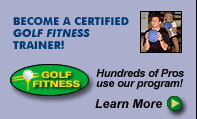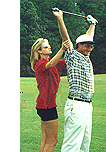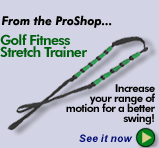
|
| |
|
|
| |
 Kelly
uses techniques like these below for the major TOUR players,
so now you can improve your game like the Pros do! Kelly
uses techniques like these below for the major TOUR players,
so now you can improve your game like the Pros do!
Basic
Guidelines to Training -
Understanding
Your Goals view...
|
The
Strong Golf Body -
Strength for Your Game
view...
|
The
Flexible Golf Body -
Flexibility for Your Game
view... |
| |
Common
Problem Areas -
The
Back
view... |
|
Basic
Guidelines to Golf Fitness Training
Understanding
Your Goals
Strength Training
Muscular
endurance and strength are key for a powerful and consistent
golf swing. Following these guidelines will help you get
the most out of your strength training sessons:
1. Quality is always more important
than quantity.
2. Learn proper technique before
adding heavier weight.
3. High volume 12 to 20 repetitions
per set and 3 to 5 sets of low-intensity
lifting will enhance muscular endurance
and facilitate a "cut" look
of muscles.
4. Low volume 6 to 12
repetitions per set and 1 to
3 sets of medium- to high-intensity
lifting will promote strength
gains with bulk applied to muscles.
5. Training parameters
of sets, reps, frequency and
intensity need to be varied every
five to six weeks to avoid a
plateau in training.
6. Never hold your breath
while lifting. Instead exhale
when you push against the resistance
and inhale as you return to the
starting position.
7. Always train opposite
muscle groups to maintain muscular
balance. If you train the front
of your arm, be sure to train
the back of your arm. Remember,
golf is a game of balance!
Cardiovascular Training
Cardiovascular
training is a must to maintain endurance while playing. The
benefits include strengthening the heart, maintaining the
integrity of your arteries, improving blood and oxygen delivery
to the muscles and weight loss. The following guidelines
are designed for cardiovascular equipment training, but also
can be applied to power walking.
1. Choose equipment that is comfortable
and familiar, such as stationary bike,
treadmill or stair climber.
2. Calculate your target heart
rate using either of these formulas:
Cardio
training:
220 minus your age multiplied by 80 percent
Weight
loss:
220 minus your age multiplied by 60 percent
3. Begin
with light resistance for 2 to 3 minutes as a warm-up.
4. Increase the resistance the next
2 to 3 minutes to reach your target heart rate.
You may need to obtain a heart rate monitor
or see if your equipment has one built in.
5. Maintain your target heart rate for
a minimum of 25 minutes.
6. Decrease the resistance for 2
to 3 minutes as a "cool down." Your
heart rate should be around 100 or less
when you are ready to get off.
7. Train a minimum of three
days a week.
NOTE: If
you do not have access to a heart rate monitor, begin with
a warm-up and gradually increase resistance. Find
the point where you can exercise moderately and
converse without gasping for air. If you are unable to
speak without stopping between words or sentences to catch
your breath, decrease the resistance to your find comfort
zone.
Subscribe
now and access over 100 exercise videos,
articles and tips anytime, anywhere!
The
Strong Golf Body
Strength for Your Game
 Like
all athletes in the top level of sports, professional
golfers make the game look easy. Their swings seem as
fluid and effortless as running water, and they look
as though they are on a leisurely stroll as they pound
drives more than 300 yards and hit high soft iron shots.
The truth is, professionals like Tiger Woods, David Duval,
Sergio Garcia, and Ernie Els as well as professionals,
such as Loren Roberts, Greg Norman, and Larry Nelson
make the game look easy, not because they aren’t
exerting themselves, but because they’re strong
and fit enough to make a complicated athletic move (the
golf swing) look simple. Like
all athletes in the top level of sports, professional
golfers make the game look easy. Their swings seem as
fluid and effortless as running water, and they look
as though they are on a leisurely stroll as they pound
drives more than 300 yards and hit high soft iron shots.
The truth is, professionals like Tiger Woods, David Duval,
Sergio Garcia, and Ernie Els as well as professionals,
such as Loren Roberts, Greg Norman, and Larry Nelson
make the game look easy, not because they aren’t
exerting themselves, but because they’re strong
and fit enough to make a complicated athletic move (the
golf swing) look simple.
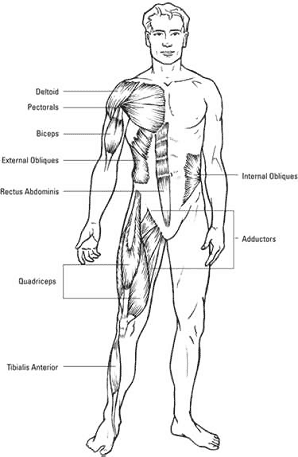 Very
few amateurs can devote that amount
of time, energy, and money to their
golf games, but that shouldn’t
stop those amateurs from making positive
changes in their games by improving
their strength and conditioning.
Over the years conditioning for athletes
has become an exact science. The
workout regimen for basketball teams
isn’t the same as the program
designed for swimmers, football players,
or tennis stars. Each sport requires
certain physical skills. Trainers
must develop programs that enhance
the specific skills needed for a
particular sport. Very
few amateurs can devote that amount
of time, energy, and money to their
golf games, but that shouldn’t
stop those amateurs from making positive
changes in their games by improving
their strength and conditioning.
Over the years conditioning for athletes
has become an exact science. The
workout regimen for basketball teams
isn’t the same as the program
designed for swimmers, football players,
or tennis stars. Each sport requires
certain physical skills. Trainers
must develop programs that enhance
the specific skills needed for a
particular sport.
Golf
is no different. Even with the advancements in equipment
and course conditioning, golf is still a game of balance,
discipline, and touch. Enhancing and improving those
specific skills requires a balanced regimen with four
equally important components: strength, flexibility,
endurance, and diet.
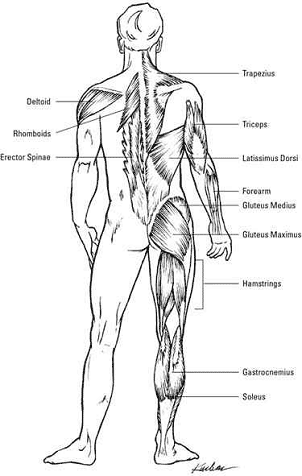 Not
that long ago many people commonly assumed that strong muscles
were slow muscles, and anyone who worked out with weights
ran the risk of becoming a muscle-bound brute incapable of
swinging a golf club or having the delicate touch necessary
for short chips, pitches, and putts. Big, strong muscles
were bad in golf, or so said the conventional wisdom. Not
that long ago many people commonly assumed that strong muscles
were slow muscles, and anyone who worked out with weights
ran the risk of becoming a muscle-bound brute incapable of
swinging a golf club or having the delicate touch necessary
for short chips, pitches, and putts. Big, strong muscles
were bad in golf, or so said the conventional wisdom.
Even in the days when this thinking was prevalent, there were
exceptions. Because the in-club gym idea hadn’t caught
on in country clubs in the 50s and 60s, Gary Player and his
friend and workout partner, amateur Frank Stranahan carried
their own free weights with them on tour, much to the chagrin
of their fellow tour players. But while others sat in the clubhouse
bars and scoffed, Player won eight major championships, while
Stranahan became the top amateur golfer in the nation and regularly
beat the world’s best professionals in head-to-head competition.
Today the value of strength in golf is almost universally recognized.
Strength in all major and minor muscle groups plays a critical
role in the golf swing:
-
Strong
abdominals and external obliques (the trunk muscles along
your sides where “love handles” normally
develop) are essential for good posture at address. This
becomes especially critical for golfers with the increased
risk of back and neck injury resulting from poor posture.
Shoulder,
arm, and upper back strength are crucial in the takeaway,
the downswing, the follow-through, and the short game.
Your swing is initiated with the shoulders and hips rotating
away from the target. The pectoralis major (the chest
muscles) aids in moving the target arm away from the
target. The forearms and wrist engage to keep the club
in a cocked position. The triceps extend to keep the
target arm straight, while the biceps flex the opposite
or non-target arm. The rotator cuff muscles work to stabilize
the shoulder girdle and turn with the shoulders and arms.
The rotator cuff of the non-target arm pulls the club
back and externally rotates the arm. The hamstrings and
external obliques assist hip rotation during the backswing,
creating a stable stance and good posture. The weight
shifts from an almost equal distribution at address to
upwards of 85 percent on the rear foot due to the redistribution
of the upper body.
The
lower back is a source of much pain and misery in many
golfers. The coiling of the upper body around a resistant
lower body coupled with the twisting of the back during
the downswing and follow-through can have devastating
results. Even in a properly executed golf swing, back
muscles pull at the lumbar, and, if a golfer isn’t
strong, the discs are susceptible to strain and injury.
Nothing can guarantee that you won’t have back
problems, even if you do everything right, but a strong
lower back is less likely to become an injured lower
back.
-
Strength
in the legs and hips are also crucial. Strong hamstrings
provide a solid base at address while the adductors (inner
thighs) and hip flexors initiate both the backswing and
the downswing. The gastrocnuemius, commonly called the
calf muscle, drives the lower body through the swing,
while the ankle flexors are critical for balance.
Subscribe
now and access over 100 exercise videos,
articles and tips anytime, anywhere!
The
Flexible Golf Body
Flexibility for Your Game 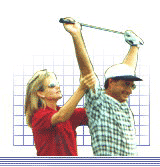
Golf requires flexibility in all parts of the body. Tight
muscles restrict and slow down the motion needed to effectively
swing the golf club and as we age, muscles aren’t as naturally
flexible and supple as they were in earlier years. That means
golfers must work harder just to maintain the same level of flexibility
they had in their twenties and thirties.
Keeping flexible requires a great deal more than simply warming
up with a few stretches at the first tee before a round. Golfers
who want to improve their games need to take flexibility training
as seriously as hitting practice balls or working on the putting
green. Here are some reasons why:
- Stiff
muscles and tendons in the trunk and lower body
inhibit proper setup and cause golfers to slouch. You
can’t make a proper golf swing from a poor setup,
and you can’t set yourself in the proper position
at address without some degree of flexibility.
Making a proper shoulder turn
is impossible if your deltoids
(the shoulder muscles), pectoralis
major (the chest muscles), obliques
(the stomach muscles) , and latissimus
dorsi (the upper back muscles) are
stiff and unresponsive. The backswing
is a turn of the upper body around
the relatively stable lower body. Upper
body flexibility makes that turn possible.
The biceps, triceps, wrist
and elbow flexors must also be flexible in
order for the arms to work properly
in the swing. You may have heard
the phrase “releasing the golf
club”. This term refers to
the point in the swing when the wrists,
elbows, shoulders, and hands work
together to generate the greatest
clubhead speed at the exact moment
the club makes contact with the ball.
In order for those body parts to
work in this synchronized fashion,
each muscle group in the arms and
shoulders must be flexible. Stiff
arms lift the club and make a slashing,
violent, and technically incorrect
swing. Supple arms swing the golf
club fluidly.
The hip flexors and adductor
muscles must also remain flexible if
you want to swing the club efficiently.
Because the lower body initiates
the downswing and provides the stable
base on which the entire swing is
structured, having a full range of
motion with these muscles is critical.
- Making
a good golf swing also depends on a flexible back and abdominal
muscles. These
opposing muscle groups are stretched to their limit in
golf and players must go to great lengths to stretch these
muscles properly. If you don’t, poor golf is the
least of your worries. You can fix a bad swing. A bad back
can last forever.
Subscribe
now and access over 100 exercise videos,
articles and tips anytime, anywhere!
Common
Problem Areas
 
Low back pain is the most
common injury I see on and
off the TOUR. Even if you have
a flawless swing, you're still
at risk for injury due to the
fact that the swing uses the
back for leverage. Each time
you make a swing, your back has
to change position, resist torque,
compress and rotate along its
own axis. The back incurs stress
as the hips rotate in the swing,
therefore most injuries occur
at the lower region of the
spine. Treatment-
Ice the area of discomfort for
20 minutes a minimum of 4 times
daily. Take an over the counter
anti-inflammatory drug as directed
to reduce swelling. The next
step is to do stretching exercises
daily and strengthening exercises
every other day. If the pain
persists, see your physician
immediately. Prevention-
Improving golf swing mechanics
is the first step to reducing
back pain. Keeping your back
strong, stretched and flexible
will aid in injury prevention.
|

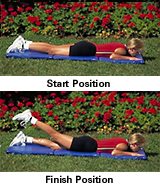 |
Recommended
Strength Exercise:
Alternate
Low Prone Lift
Start: Lie
face down with your legs
extended, arms bent and
close to your rib cage
for support. Action: Flex
your gluteal muscles (buttocks)
and lift one leg as high
as possible keeping it
straight. Slowly return
to the start position.
Repeat.
Notice: Do
not let your foot rest on
the floor. Do as many as
you can up to 10 repetitions
for beginner, 15 for intermediate
and 20 for advanced level.
Be careful not to lift the
leg too high to cause low
back discomfort. If you do
not know your current fitness
level click here to analyze
your fitness
|
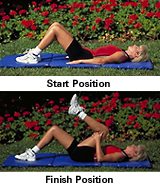 |
Recommended
Stretch:
Low
Back Stretch Start: Lie
on your back with your knees bent and feet flat on the
floor. Action: Pull
one leg toward your chest keeping your head on the floor.
Hold for 20 seconds. Return to the start position. Do the
same for the opposite side. Notice: Do
this stretch slowly and with control.
|
Subscribe
now and access over 100 exercise videos,
articles and tips anytime, anywhere! Its easy and quick...
get your unique password and access the Academy right now!
|
|
|
|

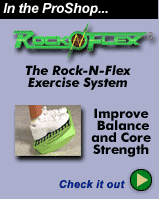

See Your Ad
Here!
Great traffic, great rates.
Email us for more
information.
|


